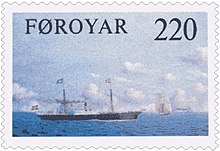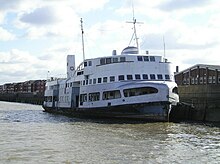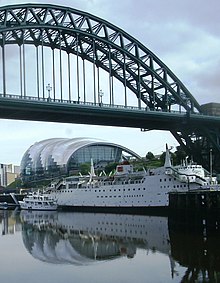William Denny and Brothers
William Denny and Brothers Limited , often simply Denny called, was one on the river Leven located shipyard in Dumbarton , Scotland . The company, founded in 1844, ceased operations in 1963. In terms of the number of ships built, Denny had the highest output of any shipyard in the Clyde area.
history
Start time
1814 William Denny built the first on Thames used steamer .
The actual Denny Brothers company was founded in 1844 by William Denny's three sons, William Junior, Alexander and Peter. As early as 1849 the name was changed to William Denny and Brothers and moved from the previously used Wood Yard to a newly built shipyard on the east bank of the Leven, near the mouth of the river in the Clyde .
William Denny
The third brother of the three company founders, William Denny, who had worked as chief designer at Robert Napier & Sons until 1849, started work in the new Denny shipyard. It was he who was behind the first sea-going steamship and a number of other innovations that made the Denny name famous. From around 1870 onwards, towing tests with various ship prototypes for the ferry service on the English Channel were carried out on behalf of the Belgian government, thus avoiding contractual penalties in the resulting construction orders. The tow tank has been preserved to this day and is used as a museum. Denny also built the first steel steamers around this time.
Peter Denny developed the shipyard's holdings in shipping companies such as the British & Burmese Steam Navigation Company from Glasgow, the Irrawaddy Flotilla Company, and the La Platense Flotilla. The shipyard therefore also delivered almost all of the newbuildings for the shipping companies British India Line and British & Burmese Steam Navigation Co. Ltd. William Denny committed in 1887, a year before the shipyard participated at the Glasgow Exhibition, suicide .
More innovations
While the Duchess of Hamilton paddle steamer was being built in 1890, the Duke of York steamer powered by two propellers was built as early as 1894 . In 1899, the yard was in second place in Great Britain in terms of the tonnage produced. After Denny had started building canal ferries early on, around 1900 the shipyard had the reputation of being the leading provider in this shipbuilding segment. The shipyard should maintain this reputation until the end. Another notable ship of this era was the first turbine-powered merchant ship, the King Edward . It also initially had five propellers on three shafts, although the outer double propellers were converted to single propellers in 1906. It was not until 1952 that the King Edward was canceled at Troon .
From 1905, Denny Brothers succeeded in winning a number of construction contracts from the Admiralty for torpedo boats , destroyers , submarines and several hospital barges for the Royal Navy and also gaining a foothold in this field.
Another "specialty" of this time were the large reefer ships for shipping companies from New Zealand and Spain . Technically outstanding in this context was the Otaki from New Zealand Shipping Co Ltd. The ship with its three propellers was the first in the world to have both outer propellers powered by triple expansion steam engines, while the middle propeller was powered by a steam turbine.
In 1911 the steam turbine-powered English Channel ferry Riviera was built. The South Eastern and Chatham Railway Company received the first turbine-powered English Channel ferry , the Queen and the ships Onward , Invicta , Victoria and Empress for the Dover - Calais ferry service . For the ferry service operated by the London, Brighton and South Coast Railway together with the French State Railways between Newhaven and Dieppe , the shipyard built the turbine steamer Paris in 1913 , which with its Yarrow boilers and geared steam turbines of the Parsons type, speeds over 25 Knot reached.
The world wars
By 1914, the shipyard with its 2,150 employees was able to build around 45,000 tons of shipping space per year. Although the experience in the construction and further development of turbine and ferry shipbuilding was most pronounced, the construction options covered the entire area of merchant shipbuilding and also extended far into military shipbuilding. A construction contract for 150 combat aircraft was also obtained in 1917. In 1918 the shipbuilding sector at Leven shipyard and the Dumbarton-based subsidiary Denny and Co. , which was initially responsible for steam engine construction and later for the production of marine diesel engines, became a single limited company, William Denny and Brothers Ltd. together.
Denny Brothers built the turbine passenger ship Curraghmore by the end of 1919 . A year later, we closed the shipyard until 1923. Later re-emerged ferries, as well as fourteen line freighter which the yard, next to orders for the Royal Navy and a large passenger ferry for the shipping company Canadian Pacific , through the time of the Great Depression brought.
In the 1930s, mostly conventional merchant ships were built. The most significant innovation of the company in this decade was the introduction of the Denny-Brown stabilizer for ships in cooperation with the Edinburgh company Brown Brothers and Co. Also worth mentioning was the construction of a car ferry, which was later converted into an auxiliary mine layer . 1939, converted the company to a stock corporation ( Limited Company to).
Before and during the Second World War , Denny built twelve destroyers, including two of the Tribal class , twelve sloops , two mine sweepers , two steam cannon boats and a large tank transport ferry. In addition, twelve liner freighters , a canal ferry, four paddle steamers and two standard hitchhikers for India as well as three aircraft transporters were delivered.
Post-war years
In the first post-war years, the shipyard stopped building smaller vehicles and reduced the number of slipways to five. The construction program then concentrated on seagoing cargo ships, ferries, excursion steamers, fishing protection vessels destined for Scotland and a frigate . As part of the development of British Railways decided by the Transport Act 1947 , Dennys manufactured ten large passenger ferries between 1947 and 1961. These included the Princess Victoria car ferry , which sank on January 31, 1953, and 179 passengers and crew died and only 44 people were rescued. Further ferries were built for the Isle of Wight , the Channel Islands and other British clients. In the late 1950s, some of the then relatively new RoRo ferries were built . In 1959 the Wert built its last warship with the anti-aircraft frigate HMS Jaguar .
After the shipyard was modernized in 1959, it had around 1,800 employees in 1961. As early as 1963, however, the company was liquidated because it did not succeed in winning enough construction contracts, especially in the bulk carrier segment that was targeted at the time. The shipyard was later demolished and a sawmill was built on the site at the former equipment pier .
In addition to the Denny towing tank , which has been preserved as a museum, and the many innovations implemented in shipbuilding, the shipyard also dealt with hovercraft technology and the further development of the helicopter . What is rather unknown is that, in addition to a few other surviving ships from the yard, the famous Cutty Sark was also completed at the Denny Brothers yard after the actual construction yard, Scott and Linton, went bankrupt.
See also
Web links
- William Denny and Brothers at Graces Guide (English)
- Peter Denny at Graces Guide (English)
- Denny and Co. at Graces Guide (English)
- Construction lists at Miramar Ship Index (English, fee-based)
Individual evidence
- ↑ Page on the development of ship stabilizers (English)




